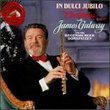| All Artists: Reinhold Gliere, Leon Botstein, London Symphony Orchestra Title: Gliere: Symphony No. 3, Op. 42 "Ilya Murometz" Members Wishing: 0 Total Copies: 0 Label: Telarc Original Release Date: 1/1/2003 Re-Release Date: 1/28/2003 Genre: Classical Style: Symphonies Number of Discs: 1 SwapaCD Credits: 1 UPC: 089408060922 |
Search - Reinhold Gliere, Leon Botstein, London Symphony Orchestra :: Gliere: Symphony No. 3, Op. 42 "Ilya Murometz"
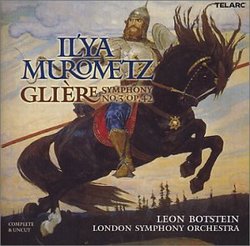 | Reinhold Gliere, Leon Botstein, London Symphony Orchestra Gliere: Symphony No. 3, Op. 42 "Ilya Murometz" Genre: Classical
This flamingly multicolored, unashamedly grand-scaled symphony receives a performance here so sonically beautiful that it's practically visible. The work is programmatic and tells of the heroic deeds of a medieval knight-s... more » |
Larger Image |
CD DetailsSynopsis
Amazon.com This flamingly multicolored, unashamedly grand-scaled symphony receives a performance here so sonically beautiful that it's practically visible. The work is programmatic and tells of the heroic deeds of a medieval knight-strongman, (translated as) "Il 'ya from the town of Murom." Given the orchestration--quadruple woodwinds, four trumpets, eight horns, four trombones, tuba, timpani, percussion, two harps, celeste, and strings--he comes across as a combination of Superman, Batman, Robin Hood, and Wagner's Siegfried. Leon Botstein brings out great warmth in the London Symphony's string section, the flute bird-curlicues in the second movement are luscious, and, in general, his leadership has nice forward propulsion in a work that can easily sound bloated. If this sort of huge, Romantic palette is your cup of tea--and it is sort of irresistible--then look no further. This realization is ravishing, and Telarc's sound is an audiophile's dream. --Robert Levine Similarly Requested CDs
|
CD ReviewsA total, unmitigated disaster from every point of view! Avrohom Leichtling | Monsey, NY | 03/10/2003 (1 out of 5 stars) "I have known this work in score (all 413 pages of it) for nearly 50 years now - and have been attentive to every recording that has surfaced. Some performances cut the guts out of the piece making a mockery of Gliere's carefully crafted architecture. Others come close to the mark. The only recording to follow GLIERE's markings accurately is still available and is conducted by Harold Farberman. The only recording which, if not entirely accurate tempo-wise, is sonically quite spectacular, and that is Sir Edward Downes'.The present recording is a colossal disaster from every perspective. When a recording announces itself as being "complete and uncut" and yet, in this case, has a performance time of 72 minutes, you know something is terribly wrong. I was antipating a solid performance from Leon Botstein, and spectacular sonics from Telarc. Neither is the case. Telarc's engineers have totally missed the boat on this recording: The LSO sounds like it was recorded in a Turkish bath house, the acoustics are so terrible. There is no definition, no balance, everything sounds muffled and totally out of kilter. This is astonishing given Telarc's past record of superlative orchestral recording.The LSO plays at its usual high level - but is totally sabatoged by Botstein's absolute dismissal of Gliere's tempo markings, either specifically or conceptually. The architecture of the four movements of this work are very carefully constructed - such that the first, second and fourth movements each have performing times between 27 and 28 minutes: yet Botstein manages the first in 22 minutes, the second in 20! and the last movement in 22. Botstein's tempi in the first movement are often not even in the same universe as Gliere's - i.e. the all important bits of liturgical chant at Rehearsal #8 are completely wrong, first measure to last. The materials given here are critical to the rest of the piece and are blown away as if they were a bit of meaningless trivia. The fourth movement, for example, begins in a "slower" tempo, progress through a series of accelerating tempi and then arrives at allegro - but is, rather, played at the arriving tempo - you know the conductor either does not know the score, or has totally misread it. The second movement builds entirely out of the "creepy" sul ponticello augmented triad blurr with which it opens - and the progression is supposed to be very, very slow. Gliere gives only one tempo marking for the movement: quarter=54. There are no accelerandi marked anywhere in the movement, and only one very brief retardando. Many of the complex figures are unplayable if the tempo is too fast - the result here is a hideous kind of sloppy rhythmic hyperventilation, not the orgasmic agitation which is, in fact, what is in the score. Here, it is all matter of fact without any feel for the "geist" of the music. The third movement lacks clarity and projection altogether. It is unlistenable. The long peroration at the end of the fourth movement, itself a very ingenious recapitulation, al roverso, of the materials that preceded it, is meaningless when it happens too soon. (See "accelerando" above). For all these (and many other reasons) I would have hoped that Mr Botstein, who is also known as a musicologist, would have paid more attention to the score. Certainly, he could have followed Gliere's markings "more closely." That he did not gives us this egregious bit of interperative charlatanism. The power of this music is fully revealed in that most fundamental of musical attributes: time. The piece works because things happen "at the right time" as much as a result of "what" happens. Gliere knows his business - and it is totally indefensible to tell the composer "you didn't write the correct tempi" in your score. Such arrogance! Such chutzpah!Avoid this recording like the plague. It is absolutely, totally wrong and negates, at virtually every point, everything that's in the score." Botstein is captivating but Downes's the real thriller! David A. Hollingsworth | Washington, DC USA | 05/19/2003 (4 out of 5 stars) "Between Tchaikovsky's and Myaskovsky's Sixth Symphonies (of 1893 and 1923 respectively), there are a few Russian symphonies written in-between them that surely stands out as among the finest in the genre: Glazunov's Eighth, Scriabin's Third, Rachmaninov's Second, and Gliere's monumental masterpiece of 1911. This score (Wagnerian in scope), which calls for quadruple woodwinds, eight horns, four trumpets, tuba, four trombones, an opulent percussion department including a celesta, two harps, and strings, combines the epic traditions of Borodin and Glazunov (to whom it's dedicated). It is strongly nationalistic in outlook, picturesque in its programming, and a strong defender of Late Romanticism. And yet notwithstanding its popularity, this score suffers from some oblivion beyond Russian borders and, in the past at least, fell victim to some rather heavy cuts especially in the outer movements (like the Stokowski and the Nathan Rakhlin recordings, the latter which is otherwise a thrilling and an exemplary account under the Melodiya/Columbia/Russian Disc labels-all nla). Thankfully, few and more recent recordings happen to be totally faithful to this extraordinary music, the earliest of such featuring Hermann Scherchen and the Vienna State Opera Orchestra (under the deleted Westminster Gold LP label-and a very hair-raising state of affairs at best).Charles B. Yulish's fascinating notes in that Melodiya/Columbia LP recording explains that Ilya Murometz, according to historians, emerged in the 10th or 11th century, about the time Kiev became a focal point in northern Russia as a center for commerce. However, Kiev became also a focal point for invaders, which prompted Prince Vladimir, son of Sviatoslav, to build a ring of fortresses to protect the city. Vladimir, who became the first to consolidate Russia, enlisted northerners for defense purposes. Ilya was among the knights recruited, and he is often credited for helping Vladimir achieve various nationalistic goals, such as bringing Christianity to Russia. Vladimir converted to Christianity, though historians differs as to why (to marry Anna, the daughter of Emperor Basil II or was it due to some calculated ploy to power). Whatever the reason, Ilya's adventures and escapades, as Yulish observes, is best understood through the Russian bylina, a secular folk song equivalent to spiritual verses often spoken poetically. Gliere, quite a master of storytelling and picturialism, wrote his own story line for the purposes of the music, which is well detailed in Anthony Burton's synopsis for this recording.Not forgetting even for a moment the Rakhlin's classic Melodiya recording or Sir Edward Downes very theatrical approach to the score, Leon Botstein, whose approach reminds me a good deal of Scherchen's, makes a very strong case for this work, and the London Symphony Orchestra responds with upmost conviction, authority, and flair. Their's a performance that ripe in more ways than one. What I like particularly about Botstein's reading is the buildup from the first movement's andante sostenuto into the very exciting and thrust forward allegro risoluto section. Even the tranquillo misterioso is arresting in its own right. But turn to andante second movement "Il'ya Murometz and Solovei the Brigand" and even the mysterious layers behind each note are well captured. The finale "The Heroic Deeds and Petrification of Il'ya Murometz" is well served also, and Botstein's sense of urgency brings extra dimensions of drama to it, though as the expense of the expansiveness especially in the climax (where after the Tartars multiplied themselves, Il'ya and his bogatyrs were turned to stones as they flee towards the mountains).This in turn arises a problem I have with Botstein's recording. Going back to Downes's 1991 Chandos recording with the BBC Philharmonic, and it is Downes who articulates the expansiveness and the spaciousness that make the story-telling more intriguing yet absorbing. Botstein is effective in this regard, but Downes is much more than that. Their timings in the first three movements are very identical, and yet it's Downes who unfolds the story behind the score more naturally. It is this momentous, heavily-scored piece where accentuation does indeed count, otherwise some of the effects would be drowned (Farberman understood this in the well, far-searching Unicorn-Kanchana recording). For example, the climax, and the poco meno section preceding it, is absolutely captivating in Downes' hands while Botstein is too fleeting and comparatively thinner in tone. And credit shall be given to Downes' BBC Philharmonic, the ensemble with more body and weight, and with more sonorous phrasings throughout than Botstein's orchestra. Furthermore, the Chandos recording sounds more intimate and involving than Telarc, with the bloom and atmosphere wonderfully at present so as to give the sound more vitality and reverberance. So, with a couple of reservations, this disc is very collectable, for Botstein, at least for some I suspect, may have set new standards in performing Gliere's masterpiece. But as for me, Botstein's performance remains a tad too symphonic while Downes' very theatrical approach serves the music even better (even to the point of using a component home theater surround system rather than going out to see an action-packed film)." Playing 9/10, recording 7/10, musical interpretation 2/10 Jackie Bushell | Oxfordshire, United Kingdom | 03/23/2003 (3 out of 5 stars) "At last a superbly recorded version of this great epic in the full version with no cuts. The playing of the LSO is technically little short of perfect, but I'm reminded of the old days of 78 rpm records, where conductors had to choose a faster speed to get a piece to fit. This seems to be what Botstein has done to meet the 80 minute CD limit. To my taste (and I have listened to all the Gliere 3 recordings) the vast epic canvas has been spoiled, with many of Gliere's metronome marks ignored. The mystery of the forest music in movement 2 is glossed over and becomes a canter - how can it be possible for Botstein to romp through in 20:14 while Farberman takes a correctly spacious 28:33? So if you are looking for a recording of this piece:
- for the full version at the correct tempi, choose Farberman with the Royal Philharmonic, on 2 CDs - for technical excitement, but few spine chills, go for LSO with Botstein - for a good compromise, get the BBC Philharmonic with Downes - as an excellent introduction, see if you can find a record of the Philadelphia Orchestra with Ormandy - cut to only 65 minutes, but all the best music.For further info about Gliere and his Third Symphony, see my website (type 'gliere' into Google and look for clarihorn)." |

 Track Listings (4) - Disc #1
Track Listings (4) - Disc #1
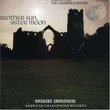


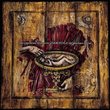

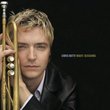

![Across The Universe [Deluxe Edition]](https://nationalbookswap.com/cd//m/51/1251/1241251.jpg)
